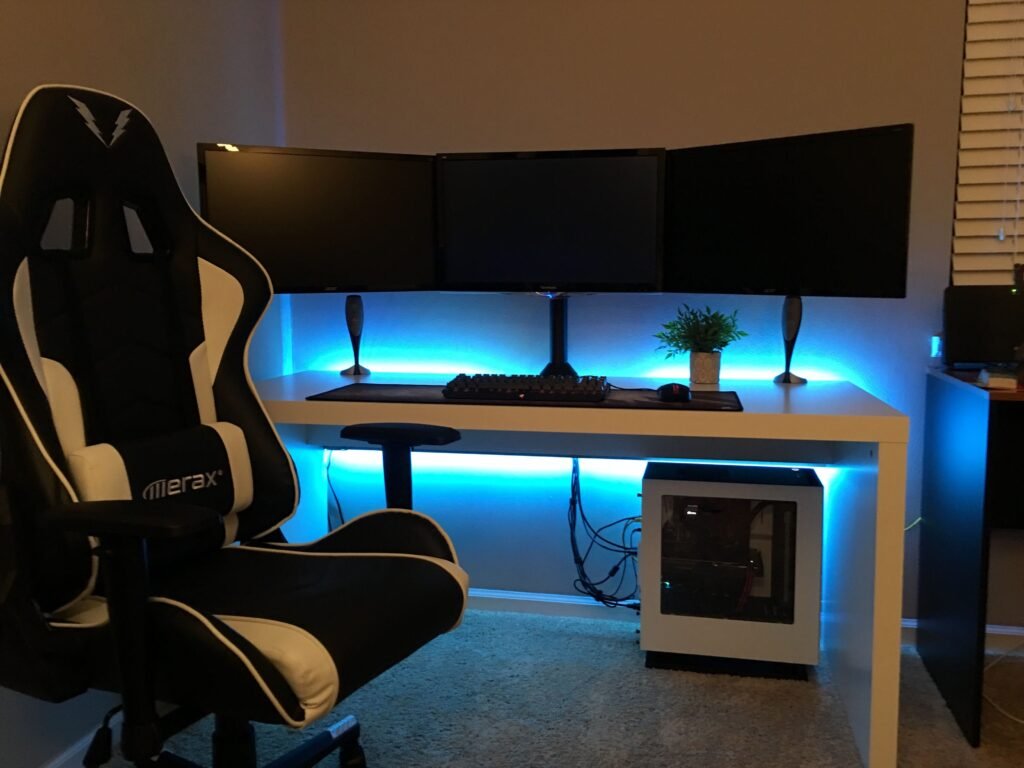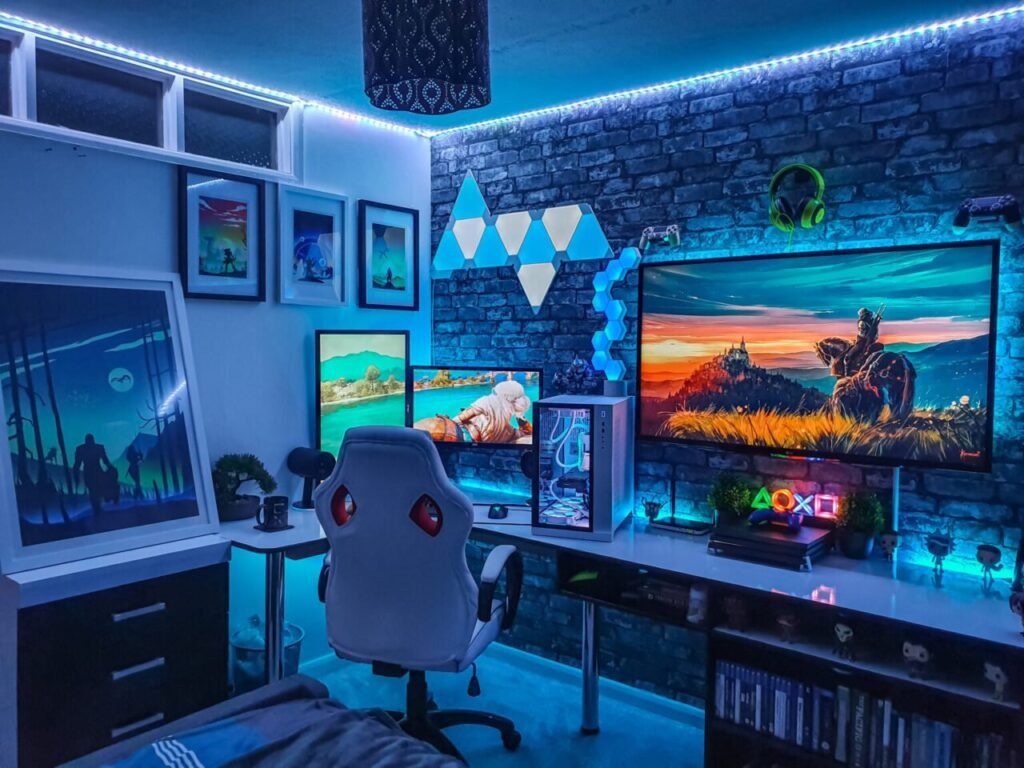The Rise of RGB Lighting in Gaming
RGB lighting has transformed remarkably in gaming setups over the past decade, evolving from an exclusive niche to a widely embraced feature across various gaming accessories and personal computers. Initially, RGB lighting was primarily found in high-end gaming gear and custom-built PCs, often viewed as a luxury rather than a necessity. However, as the gaming community expanded and technology progressed, it became clear that RGB lighting offers more than mere aesthetic appeal; it enhances the overall gaming experience.
The appeal of RGB lighting lies in its ability to create an immersive environment, allowing gamers to personalize their setups according to their preferences. Whether it’s through setting dynamic color patterns that react to in-game actions or using fixed color schemes that reflect a gamer’s personality, RGB lighting establishes a unique ambiance. This customization fosters a deeper emotional connection to the gaming experience and elevates the enjoyment of gameplay. Moreover, the growing community around RGB setups has contributed to this trend, with countless online resources and social media platforms dedicated to showcasing innovative lighting arrangements and effects.
Technological advancements have played a crucial role in making RGB lighting more accessible and customizable for gamers. The introduction of software solutions that allow easy integration and synchronization of RGB lighting across multiple devices has revolutionized the landscape. Brands now offer extensive compatibility with various peripherals, such as mice, keyboards, and headsets, enabling users to realize their vision effortlessly. Furthermore, with the introduction of smart RGB lighting systems, gamers can now control their setups through mobile applications or voice commands, simplifying customization. Overall, RGB lighting has shifted from being a mere aesthetic feature to a fundamental aspect of modern gaming culture, enhancing both functionality and user experience.

Does RGB Lighting Enhance Gaming Performance?
The impact of RGB lighting on gaming performance is a topic of considerable debate among gamers and researchers alike. While the majority of players appreciate the visual appeal of RGB setups, the question remains: does this colorful illumination actually enhance gaming efficiency? To address this, we must consider both the psychological effects and measurable performance metrics associated with RGB lighting.
Several studies suggest that immersive environments, facilitated by RGB lighting, can positively affect player focus and engagement. The use of dynamic lighting colors in gaming can create an atmosphere that enhances the emotional experience, potentially leading to increased motivation and concentration. This sort of psychological benefit, while subjective, can have a tangible effect on performance when players feel more involved and relaxed during gameplay.
However, when assessing performance through objective metrics such as frames per second (FPS) and response time, RGB lighting’s influence becomes less apparent. Performance in high-stakes gaming scenarios largely depends on hardware capabilities, network stability, and individual skill rather than on the aesthetic elements of a player’s setup. Experts argue that while RGB lighting may not directly boost these performance metrics, it can contribute to the overall experience, enabling players to feel more immersed and therefore possibly play better over extended gaming sessions.
Moreover, it is essential to differentiate between distraction and motivation regarding RGB lighting. Critics often claim that the presence of vibrant colors can divert attention, yet many gamers find that well-implemented lighting enhances their focus. A balanced approach to RGB integration, where lighting elements respond to in-game actions or functions, can minimize this distraction, reinforcing the belief that RGB lighting may play a nuanced role in gaming performance.

Integrating RGB Lighting into Your Gaming Setup
Incorporating RGB lighting into your gaming setup can elevate your gaming experience, transforming not just the aesthetics of your environment but also how you engage with your games. Various types of RGB lighting options are available, and understanding these can help in making informed choices that suit your individual gaming needs.
LED strips are a popular choice for gamers, allowing for versatile placement around monitors, desks, or even walls. These strips often come with adhesive backing and can be cut to size, enabling seamless integration into any gaming environment. Additionally, RGB peripherals such as keyboards, mice, and mouse pads have gained significant traction. These devices often feature customizable lighting effects and patterns that allow for a personalized glow, enhancing the overall ambiance of your gaming space.
Case lighting is another crucial aspect to consider. Many gaming PC cases come with built-in RGB lighting options or RGB fans that can sync with your other peripherals. When selecting RGB components, compatibility is key. Look for hardware that supports industry-standard RGB software protocols such as ASUS Aura Sync, MSI Mystic Light, or Corsair iCUE. This compatibility allows for synchronized lighting effects that create a cohesive visual experience, aligning your lighting patterns with the flow of the game.

When installing RGB lighting, it is essential to strike a balance; overwhelming brightness can detract from the gaming experience. Opt for softer lighting in areas adjacent to the monitor to reduce glare while accentuating highlights. Consider groupings of colors that reflect the mood of the game; for instance, calmer hues for immersive RPGs or vibrant colors for action-packed titles. This strategic approach not only enhances the visual appeal but also improves focus and immersion during gameplay. By thoughtfully integrating RGB lighting, gamers can create a visually stunning setup that enriches their overall gaming experience.
The Future of RGB Lighting in Gaming
The future of RGB lighting in gaming setups promises intriguing developments that go beyond mere aesthetics. As gaming technology continues to evolve, so too does the potential for RGB lighting to enhance the overall gaming experience. Emerging trends indicate that artificial intelligence (AI) will play a pivotal role in customizing lighting effects, aligning them with in-game actions, and catering to individual gamer preferences. By analyzing player behavior and game dynamics, AI can create an immersive environment where lighting not only complements gameplay but also responds dynamically to the unfolding narrative.
One significant innovation on the horizon is the integration of RGB lighting with virtual reality (VR) and augmented reality (AR). As these technologies gain traction, lighting will likely evolve to enhance immersion, providing a synchronized atmosphere that pulls gamers deeper into their virtual worlds. Imagine a scenario where light fixtures adjust in real-time according to game events, such as environmental shifts, character movements, or narrative peaks. This level of interaction could redefine user engagement and set a new standard for gaming environments.
Additionally, the concept of modular RGB lighting systems is expected to gain popularity. These systems would allow gamers to personalize their setups with ease, modifying lighting placements and effects based on their style and the gaming scenario. Such adaptability ensures that user experience remains at the forefront of design, enabling gamers to fine-tune their environments to suit various gaming genres and moods.
In conclusion, the future of RGB lighting in gaming setups looks bright and promising with the potential for unprecedented customization and interaction. As technology continues to advance, gamers can expect to see innovative applications that not only illuminate their spaces but also transform their overall gaming experiences, creating more immersive and personalized environments than ever before.

0 Comments